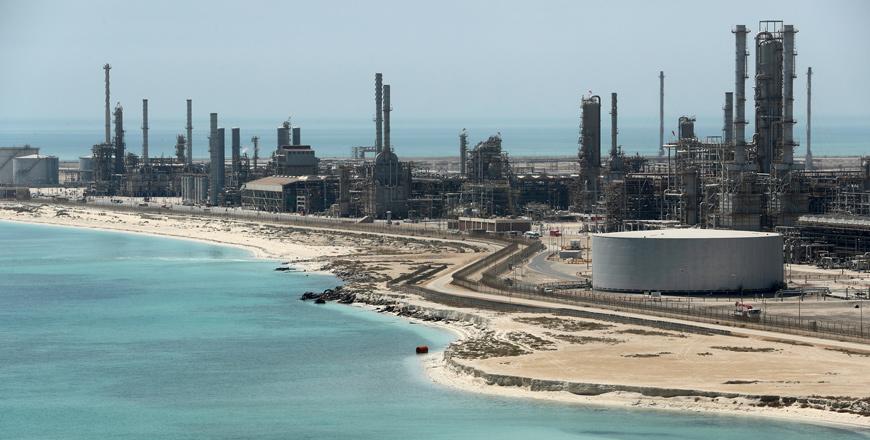You are here
Oil drops towards $57 after largest US stock build since 2001
By Reuters - Apr 08,2015 - Last updated at Apr 08,2015
LONDON — Oil prices fell towards $57 a barrel on Wednesday after the largest weekly build in US crude inventories since 2001 and as Saudi Arabia reported record output in March.
The US Energy Information Administration (EIA) reported that US stocks of crude oil rose in the week to April 3 by 10.9 million barrels — the largest weekly build since March 2001 — to a record 482.39 million barrels.
A Reuters poll of analysts had forecast a build of 3.4 million barrels.
"The report is very bearish with the large crude oil inventory build and the somewhat surprising rise in gasoline inventories," said John Kilduff, partner at Again Capital LLC. in New York.
Brent May crude was down $2.06 at $57.04 a barrel by 1444 GMT and US May crude dropped $2.34 to $51.64 a barrel.
Both benchmarks posted strong gains in the past two sessions but are still down about 50 per cent since June last year.
Adding to the global oil supply, Saudi oil minister Ali Al Naimi said late on Tuesday that Saudi output would likely remain around 10 million barrels per day (bpd) after posting a record high of 10.3 million bpd in March.
Naimi also said the kingdom stood ready to "improve" prices but only if producers outside the Organisation of the Petroleum Exporting Countries (OPEC) joined the effort.
Iraq and Libya also increased their output for March, further adding to OPEC production, which came to about 31.5 million bpd last month, according to analyst Olivier Jakob at Swiss-based Petromatrix.
"With such a level of OPEC production it will be difficult to escape large stock-builds throughout the year," he said in a note.
Iranian oil officials are in Beijing this week to discuss oil sales and Chinese investments in Iran, just days after Tehran and world powers reached a framework nuclear deal.
Still, any significant increase in Iranian oil exports is unlikely until 2016, analysts have said.
Separately, Libya's OPEC governor said OPEC should change course and cut oil supply by 800,000bpd or more to prevent an expected return of Iranian exports from weighing on prices.
The comments underline how the halving of oil prices from $115 a barrel in June on global oversupply is hurting OPEC's less wealthy members outside the Gulf and suggests the 12-nation group remains divided over the impact of its 2014 policy shift to defend market share, not prices.
"OPEC members, as a unit, need to re-evaluate their strategies," Samir Kamal, Libya's OPEC governor and head of planning at the North African country's oil ministry, told Reuters by email.
They "need to reach an agreement to bring down the production levels by at least
800,000bpd, especially now that an agreement has been reached with Iran which is expected to increase its production", he said.
A framework deal announced last week to curb Iran's nuclear work could eventually allow Tehran to boost oil exports, which have been cut by almost half since 2012 due to Western sanctions.
Four years after the ousting of leader Muammar Qadhafi, Libya is struggling with two rival governments. Kamal represents Libya on OPEC's board of governors, a body that influences but does not decide OPEC policy.
When the producer group last met in November, Libya was among member countries calling for a cut in production.
OPEC meets again on June 5 to set policy. Although they did not oppose the group's no-cut decision of last year, other non-Gulf OPEC members such as Venezuela and Iran have expressed misgivings about it and sought supply reductions.
A group of 18 African oil producers, many of which are not OPEC members, is lobbying for output curbs to boost prices that it says have fallen to levels that threaten to spark social unrest.
But without support from Saudi Arabia and the other Gulf OPEC members, a rethink is unlikely. Saudi Arabia has increased production to a record high and Kuwait has said OPEC will not change policy at the June meeting.
Related Articles
DUBAI/LONDON — OPEC will probably revive talks on freezing oil output levels when it meets non-OPEC nations next month as top exporter Saudi
DUBAI — Saudi Arabia plans to cut its crude oil exports in April to below 7 million barrels per day (bpd), while keeping its output well bel
RIYADH — Saudi Arabia said on Monday it will raise its oil exports to a record 10.6 million barrels per day starting from May, escalating a



















